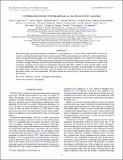| dc.contributor.author | Quintana, Elisa V. | |
| dc.contributor.author | Rowe, Jason F. | |
| dc.contributor.author | Barclay, Thomas | |
| dc.contributor.author | Howell, Steve B. | |
| dc.contributor.author | Ciardi, David R. | |
| dc.contributor.author | Demory, Brice-Olivier | |
| dc.contributor.author | Caldwell, Douglas A. | |
| dc.contributor.author | Borucki, William J. | |
| dc.contributor.author | Christiansen, Jessie L. | |
| dc.contributor.author | Jenkins, Jon M. | |
| dc.contributor.author | Klaus, Todd C. | |
| dc.contributor.author | Fulton, Benjamin J. | |
| dc.contributor.author | Morris, Robert L. | |
| dc.contributor.author | Sanderfer, Dwight T. | |
| dc.contributor.author | Shporer, Avi | |
| dc.contributor.author | Smith, Jeffrey C. | |
| dc.contributor.author | Still, Martin | |
| dc.contributor.author | Thompson, Susan E. | |
| dc.date.accessioned | 2015-01-29T18:27:30Z | |
| dc.date.available | 2015-01-29T18:27:30Z | |
| dc.date.issued | 2013-04 | |
| dc.date.submitted | 2012-09 | |
| dc.identifier.issn | 0004-637X | |
| dc.identifier.issn | 1538-4357 | |
| dc.identifier.uri | http://hdl.handle.net/1721.1/93201 | |
| dc.description.abstract | We present high precision photometry of Kepler-41, a giant planet in a 1.86 day orbit around a G6V star that was recently confirmed through radial velocity measurements. We have developed a new method to confirm giant planets solely from the photometric light curve, and we apply this method herein to Kepler-41 to establish the validity of this technique. We generate a full phase photometric model by including the primary and secondary transits, ellipsoidal variations, Doppler beaming, and reflected/emitted light from the planet. Third light contamination scenarios that can mimic a planetary transit signal are simulated by injecting a full range of dilution values into the model, and we re-fit each diluted light curve model to the light curve. The resulting constraints on the maximum occultation depth and stellar density combined with stellar evolution models rules out stellar blends and provides a measurement of the planet's mass, size, and temperature. We expect about two dozen Kepler giant planets can be confirmed via this method. | en_US |
| dc.description.sponsorship | United States. National Aeronautics and Space Administration (Association of Universities for Research in Astronomy, Inc. Contract NAS-526555) | en_US |
| dc.description.sponsorship | United States. National Aeronautics and Space Administration. Office of Space Science (Grant NNX09AF08G) | en_US |
| dc.language.iso | en_US | |
| dc.publisher | IOP Publishing | en_US |
| dc.relation.isversionof | http://dx.doi.org/10.1088/0004-637x/767/2/137 | en_US |
| dc.rights | Article is made available in accordance with the publisher's policy and may be subject to US copyright law. Please refer to the publisher's site for terms of use. | en_US |
| dc.source | American Astronomical Society | en_US |
| dc.title | CONFIRMATION OF HOT JUPITER KEPLER-41b VIA PHASE CURVE ANALYSIS | en_US |
| dc.type | Article | en_US |
| dc.identifier.citation | Quintana, Elisa V., Jason F. Rowe, Thomas Barclay, Steve B. Howell, David R. Ciardi, Brice-Olivier Demory, Douglas A. Caldwell, et al. “CONFIRMATION OF HOT JUPITER KEPLER-41b VIA PHASE CURVE ANALYSIS.” The Astrophysical Journal 767, no. 2 (April 5, 2013): 137. © 2013 The American Astronomical Society | en_US |
| dc.contributor.department | Massachusetts Institute of Technology. Department of Earth, Atmospheric, and Planetary Sciences | en_US |
| dc.contributor.mitauthor | Demory, Brice-Olivier | en_US |
| dc.relation.journal | Astrophysical Journal | en_US |
| dc.eprint.version | Final published version | en_US |
| dc.type.uri | http://purl.org/eprint/type/JournalArticle | en_US |
| eprint.status | http://purl.org/eprint/status/PeerReviewed | en_US |
| dspace.orderedauthors | Quintana, Elisa V.; Rowe, Jason F.; Barclay, Thomas; Howell, Steve B.; Ciardi, David R.; Demory, Brice-Olivier; Caldwell, Douglas A.; Borucki, William J.; Christiansen, Jessie L.; Jenkins, Jon M.; Klaus, Todd C.; Fulton, Benjamin J.; Morris, Robert L.; Sanderfer, Dwight T.; Shporer, Avi; Smith, Jeffrey C.; Still, Martin; Thompson, Susan E. | en_US |
| mit.license | PUBLISHER_POLICY | en_US |
| mit.metadata.status | Complete | |
